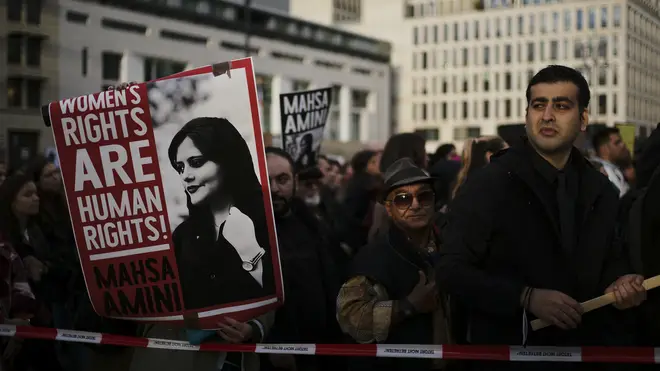
Clive Bull 1am - 4am
30 September 2022, 17:34

The demonstrations broke out after the death in custody of Mahsa Amini.
Iran’s intelligence ministry says it has arrested nine foreigners over recent anti-hijab protests sweeping the country.
In a statement carried by the state-run news agency IRNA, the ministry said those arrested included citizens of Germany, Poland, Italy, France, the Netherlands and Sweden.
The death in custody of Mahsa Amini, who was detained for allegedly wearing the mandatory Islamic headscarf too loosely, has triggered an outpouring of anger at Iran’s ruling clerics.
Her family say they were told she was beaten to death in custody. Police say the 22-year-old died of a heart attack and deny mistreating her, and Iranian officials say her death is under investigation.

Iran has claimed that the daily protests that have swept the country for the past two weeks were instigated by foreigners.
Protesters have denied such claims, portraying their actions as a spontaneous uprising against the country’s strict dress code, including the compulsory hijab for women in public.
The intelligence ministry statement came after Amnesty International said leaked government documents showed that Iran ordered its security forces to “severely confront” anti-government demonstrations.
The rights group said security forces have killed at least 52 people since protests over the death of a woman detained by the morality police began nearly two weeks ago, including by firing live ammunition into crowds and beating protesters with batons.
It said security forces have also beaten and groped female protesters who remove their headscarves to protest over the treatment of women by Iran’s theocracy.
Remember their names.
📢 Take action now. #ProtectTheProtest #Mahsa_Amini pic.twitter.com/oLdPzrtnA1
— Amnesty International (@amnesty) September 30, 2022
The IRNA news agency reported renewed violence in the city of Zahedan, near the borders with Pakistan and Afghanistan. It said gunmen opened fire and threw firebombs at a police station, setting off a battle with officers.
It said police and passers-by were wounded, but did not say whether the violence was related to the anti-government protests. The region has seen previous attacks on security forces claimed by militant and separatist groups.
Videos circulating on social media showed gunfire and a police vehicle on fire. Others showed crowds chanting against the government. Video from elsewhere in Iran showed protests in Ahvaz, in the south west, and Ardabil, in the north west.
Amnesty said it obtained a leaked copy of an official document saying that the General Headquarters of the Armed Forces ordered commanders on September 21 to “severely confront troublemakers and anti-revolutionaries”.
The rights group said the use of lethal force escalated later that evening, with at least 34 people killed that night.
It said another leaked document shows that, two days later, the commander in Mazandran province ordered security forces to “confront mercilessly, going as far as causing deaths, any unrest by rioters and anti-Revolutionaries”, referring to those opposed to Iran’s 1979 Islamic Revolution, which brought the clerics to power.
“The Iranian authorities knowingly decided to harm or kill people who took to the streets to express their anger at decades of repression and injustice,” said Agnes Callamard, Amnesty International’s secretary general.
“Amid an epidemic of systemic impunity that has long prevailed in Iran, dozens of men, women and children have been unlawfully killed in the latest round of bloodshed.”
Amnesty did not say how it acquired the documents.
Iranian state TV has reported that at least 41 protesters and police have been killed since the demonstrations began on September 17. An Associated Press count of official statements by authorities tallied at least 14 dead, with more than 1,500 demonstrators arrested.
The New York-based Committee to Protect Journalists said on Thursday that at least 28 reporters had been arrested.
Iranian authorities have severely restricted internet access and blocked access to Instagram and WhatsApp, which are used by protesters to organise and share information.
That makes it difficult to gauge the extent of the protests, particularly outside the capital Tehran. Iranian media have only sporadically covered the demonstrations.
Iranians have long used virtual private networks and proxies to get around the government’s internet restrictions. Shervin Hajipour, an amateur singer in Iran, recently posted a song on Instagram based on tweets about Ms Amini that received more than 40 million views in less than 48 hours before it was taken down.
The non-governmental Iran Human rights Organisation said Hajipour had reportedly been arrested.